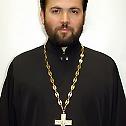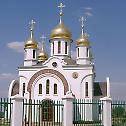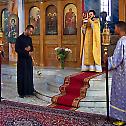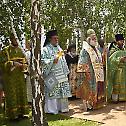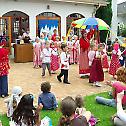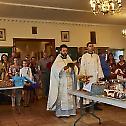“Whether in Africa Or Russia, Orthodox Parish Life Is Basically the Same”
A talk with the rector of the Church of St. Sergius of Radonezh in Johannesburg (South Africa), Archpriest Daniel Lugovoy
The parish in honor of St. Sergius, Abbot of Radonezh and Wonderworker of All Russia, was founded in the city of Johannesburg in the Republic of South Africa by the decision of the Holy Synod of the Russian Orthodox Church on December 29, 1998.
Initially the parish was accommodated in a small house where a house church was organized and held regular services. The first rector, appointed by the Holy Synod, was Archpriest Sergy Rasskazovsky, a teacher of the St. Petersburg Theological Academy, who organized the parish community, found a suitable plot of land for the construction of the future church and launched a fundraising program to obtain it. In September 2000, a piece of land was obtained in the town of Midrand, a suburb of Johannesburg, halfway between Johannesburg and Pretoria.
In February 2000, the newly-appointed church rector, Hieromonk Philaret (Bulekov), arrived in South Africa (now he is an archimandrite and Vice-Chairman of the Moscow Patriarchate’s Department for External Church Relations) and started building the church.
With the help of Russian benefactors and donations from numerous parishioners, coupled with the efforts of the rector, Fr. Philaret (Bulekov), major design work on the building of the church complex that comprised a church, a parish center, and a rectory was completed by March 2003.
On March 2, 2003, the then DECR Chairman Metropolitan Kirill of Smolensk and Kaliningrad (now Patriarch of Moscow and All Russia) consecrated the church with Metropolitan Seraphim of Johannesburg and Pretoria (the Patriarchate of Alexandria) concelebrating.
In October 2004, Archpriest John Lapidus was appointed the new rector. In the years of his ministry a Sunday school was opened (for it a spacious building was added to the parish center), a playground was equipped, a young mothers’ club was opened, the church website was created, and regular services began in Cape Town and Durban. Over 2007-2008 the church walls were covered with icons and frescoes by a team of masters from St. Petersburg Academy of Arts.
Today the church rector is Archpriest Daniel Lugovoy. Fr. Daniel was born on December 1, 1976, in Moscow.
In 1994, he graduated from the Moscow Orthodox Lyceum of Spiritual Culture and entered the Moscow Theological Seminary, which he completed in 1997. He studied at the Moscow Theological Academy between 1997 and 2001. From 1994 till 1995 he sang in the Academy Choir under the direction of Igumen Nikifor (Kirzin). From September 1995 till March 2001 he served as a subdeacon of His Holiness Patriarch Alexei II of Moscow and All Russia. In 2002, he was awarded a Master’s Degree in Theology for his thesis, entitled The History of the St. Savva of Storozhev Monastery (located just west of Moscow).
On March 17, 2001, Fr. Daniel was ordained a deacon by His Holiness Patriarch Alexei II at Danilovsky (St. Daniel’s) Monastery in Moscow and sent to serve as a deacon at the Holy Trinity Church in Konkovo (Moscow) by Patriarchal decree.
In May 2002, by the decree of Patriarch Alexei II he was transferred to the Church of St. Catherine the Greatmartyr in Vspolye, Moscow (now the Representation Church of the OCA). On May 9, 2004, he was ordained a priest by Archbishop Alexei of Orekhovo-Zuyevo (†2013).
On October 10, 2009, by the decision of the Holy Synod of the Russian Orthodox Church he was appointed rector of the Church of St. Sergius of Radonezh in Johannesburg, South Africa.
We offer our readers a talk with Archpriest Daniel Lugovoy.
The path to the priestly ministry
—Fr. Daniel, at one time you served as a subdeacon of His Holiness Patriarch Alexei II. Can you tell us a little about his personality? What role did His Holiness play in your development?
—I was baptized in my childhood near the ancient Savvino-Storozhevsky Monastery [about thirty miles west of Moscow]. At that time the famous monastery was still closed and its territory was occupied by the Zvenigorod Historical, Architectural and Art Museum. Several years later, Fr. John Borisov who had baptized our family took me into the sanctuary and I began to serve as an acolyte. It can be said that it was at that time that my path to the priestly ministry began. On that path I was blessed to meet many clerics each of whom left a deep impression on my soul. In those years churches were being reopened and parish life was being revived after a long period of persecutions. The desire to follow in my spiritual mentors’ footsteps and to enroll in a theological seminary after school kept increasing inside me. Archpriest Vladimir Chuvikin played a special role in this. In the years preceding my studies at the seminary I served as an acolyte, a reader and later - a choir singer at St. Nicholas Church of the former Nikolo-Perervinsky Monastery in the south of Moscow.
For five and a half years during my studies at the Moscow Theological Academy and Seminary I served as a subdeacon of His Holiness Patriarch Alexei II. Then I gained a great deal of experience as a future priest and simply as a human being. It allowed me to see the revival of Church life not only in Moscow but almost on the whole canonical territory of the Russian Orthodox Church. For all of us subdeacons, His Holiness Patriarch Alexei II was a model of love, patience, and pastoral devotion to his ministry, along with an awareness of his responsibilities towards God and people. Whenever he celebrated a Church service he would give himself up to it 100 per cent. There is a term “zealous celebration of Church services”. It is difficult to describe it in words, but one can see and sense it. And Patriarch Alexei II of blessed memory possessed this rare gift. Prayerfully remembering His Holiness, I try to follow his example to the best of my humble abilities.
In faraway Africa
—In 2009, by the decision of the Holy Synod of the Russian Orthodox Church you were appointed rector of the Church of St. Sergius of Radonezh in the city of Johannesburg in the Republic of South Africa. How did you react to this appointment and then adapt to life on the African continent?
—The question about my reaction to the appointment is not an easy one. I mean, there is no clear and unambiguous answer to it. On the one hand, I accepted the decision of our hierarchy, placomg my hopes in “Divine grace, which always heals that which is weak, and completes that which is lacking,” as the prayer from the ordination service reads. On the other hand, I worried about how my family would live in a new place so far away from Russia.
In January 2010 Moscow was experiencing a real winter, with sharp frosts and lots of snow. So the contrast when my family and I arrived in South Africa soon after my appointment was all the more striking. The process of adaptation took months. I cannot say that it was too hard for us. Solving specific domestic problems we were faced with enabled us to know the life in South Africa better.
Initially everything seemed unfamiliar. For example, we had summer in winter and vice versa. When we celebrated the Nativity of Christ and the New Year, we would have heat, the bright summer sun and blue sky rather than snow. Besides, in South Africa they drive on the left-hand side of the road. In this country you have to comply with very strict personal safety and security regulations. Such is its reality. In Johannesburg electric fencing catches your eye at every turn; when you leave home you must not only switch off the light (as we did in Moscow) but also turn your alarm system on.
On the other hand, the pace of life is much slower; there is no hustle and bustle there. Perhaps thanks to this attitude toward life in South Africa you see friendly and optimistic people around you. Some may argue that these are just outward manifestations, but sometimes you are really encouraged by the smile of a stranger in the street. In addition, this is not the Africa that somebody living in the northern hemisphere may imagine. The climate is mild and comfortable; roads and infrastructure are of European standards. Having travelled a bit across the country, we found that electric fences are not everywhere—in a small town you can easily see low fences that you can step over.
—Fr. Daniel, what challenges did you face during the first stage of your ministry in South Africa?
—Thanks to the labors of my predecessors there were no difficulties in my ministry. The church was in excellent condition with all the necessary vessels and furnishings. The choir sang, and the church was filled with worshippers.
One of the most difficult things was understanding what I heard in English. Although I had learned English and had speaking practice, it was not so easy all the same. All the more so because there are several ethnic groups in South Africa, each with its own accent.
The lack of a public transportation system in the city is one of the chief disadvantages. Most of the white residents travel only in their own vehicles. Therefore, many of our parishioners are unable to attend Church services on weekdays and in the evening.
Since the distance from Moscow to Johannesburg is over 5,600 miles, we have problems with supplementing our parish library, purchasing candles, and so on; but the Lord regularly sends us generous people. With their help we are supplied with all the things necessary for holding Church services and developing our parish life.
—What impression do you have of the South African Republic, a country with a checkered history, with its long walk from apartheid to the freedom of our days?
— Although the relations between various groups of the South African population are not always stable, the country managed to avoid upheavals in the transitional period of the mid-1990s. During that period, power was peacefully handed over from the white to the black. The South African Society calls itself a “rainbow nation”. Although all the parts of the rainbow have distinct contours and colors, they constitute one, integral, indivisible, harmonious whole. It is a fine example of what any nation in the world (not only South Africa) should strive for.
—Can you tell us more about your parishioners? What do they do? What are your traditions and are they different from those of Church life in Russia?
—Whether in Africa or inRussia, Orthodox parish life is basically the same. One of the peculiarities of a (Russian) parish abroad is its permanent structure. Another peculiarity is that many of the parishioners were not church going before moving to South Africa and started integrating into Church life while living abroad.
According to the latest estimates, up to 5,000 Russian-speaking people currently reside in South Africa. The majority of them came here in the 1990s from the former USSR. The diaspora communities are very diverse. You can find teachers, scientists, businessmen, musicians and many others among its representatives.
South Africa has no Russian cultural center or any other center where people can meet. Whether on a business trip or after emigration to South Africa, people often come to church not only for spiritual support, but also for information support, including about worldly things—some are seeking employment, others want to recruit staff for their new projects. Whether they are newcomers or emigrants who moved here years ago, all of them need to communicate in their mother tongue, to feel connected with others, to receive moral and material support. People gather at the Church of St. Sergius of Radonezh not only to pray and participate in Church sacraments, but also to share the joy of communicating in their native language, to help children develop their home language skills and introduce them to Russian culture. There is a library with the largest collection of Russian books in the whole of the southern Africa here. The parish has a Sunday school, holds festive concerts, and hosts cultural events.
—Do you know any native Africans who were converted to Orthodoxy?
—First of all, I’d like to point out that the terms “native Africans” and “native South Africans” have multiple meanings. When it comes to white South Africans, there are representatives in our parish; many of them were baptized in one of the Greek Orthodox churches of Johannesburg or Pretoria. When the Russian church was opened, they became members of the community of St. Sergius of Radonezh. Over the years of my ministry here, several black South Africans have converted to Orthodoxy. In most cases it was when they married Russian members of the community. However, they hardly ever showed up afterwards. As a result of their Protestant upbringing it is extremely hard for them to integrate into Orthodox parish life.
I repeat several litanies and the Gospel reading in English for our English-speaking parishioners at every Sunday Liturgy, and once a month I celebrate the Liturgy entirely in English.
—What can you say about the mentality of the local population? What is their attitude towards the Holy Scriptures and the life of the Church?
—The society in South Africa is much more religious than, say, the European society. According to the latest statistics, six out of ten South African residents (sixty-three percent) pray every day.
The fact that the vast majority of South Africans call themselves Christians has a positive effect on the role of Christianity in the country. Four out of five South Africans trust the Christian Church more than state and social institutions, while the level of trust in the police and trade unions is the lowest.
However, quite a few of the representatives of the black community in South Africa, being just nominal Christians, still follow traditional African religious beliefs and the cult of ancestral spirits, and keep their local traditions and customs. All in all, South African society is tolerant of religious diversity and is not prone to place one faith above another.
The first things that surprise South Africans who are newcomers to an Orthodox church are our gilded domes, the absence of church pews and the fact that we stand through the services.
—In addition to the parish in Johannesburg, you provide pastoral care to some Orthodox communities in a number of other African countries. Can you tell us a few words about the life of these communities? What countries do you to visit?
—It is interesting that Orthodox Christians can be found everywhere. It often amazes me that Divine providence sometimes brings people to faraway places. One can find our compatriots virtually in all large cities across the African continent. The most active Orthodox communities are in the South African cities of Cape Town, Durban, and in Windhoek, the capital city of Namibia (regular services are held there). The parish of Cape Town has its own choir, and Orthodox Namibians intend to form a parish choir too. I also visited Mozambique and Zimbabwe. The service in Maputo, the capital city of Mozambique, was the most “exotic”, as it were. In the middle of the summer it was hot, and the air was humid. The doors of the Greek Orthodox cathedral were wide open, and the Cherubic Hymn was being sung. Meanwhile African folk songs resounded from the neighboring building, the local registry office and former parish office, nearly drowning out the small church choir.
—Your parish of St. Sergius of Radonezh belongs to the jurisdiction of the Patriarchate of Alexandria. Can you tell us about your relations with your ruling hierarch and with His Beatitude Pope and Patriarch Theodore (Theodoros) II of Alexandria and All Africa? Do they often come to your parish?
—The whole of the African continent is the canonical territory of the Orthodox Patriarchate of Alexandria. Our current ruling hierarch is Bishop Damaskinos of Johannesburg and Pretoria. He celebrates services at our church several times a year. Every year we have diocesan meetings and I take part in them as well. Over the years of my ministry in South Africa I have been formally a cleric of the Diocese of Johannesburg of the Patriarchate of Alexandria. Its primate, Pope and Patriarch Theodore II of Alexandria and All Africa, has visited our St. Sergius parish a number of times. His Beatitude speaks good Russian; he loves Russia and Russian culture, and speaks to our parishioners in a very warm, friendly manner.
—Are there any other Orthodox communities in Johannesburg and elsewhere in South Africa besides your Russian-speaking parish? What can you say about your relations with their rectors?
—There are currently two dioceses of the Patriarchate of Alexandria on the territory of South Africa—those of Johannesburg and Pretoria and of the Cape of Good Hope. In addition to the Russian parish of St. Sergius of Radonezh, the South African province of Gauteng has a few other Orthodox parishes, namely Serbian, Romanian, and Bulgarian. I have maintained good, fraternal relations with their rectors. We meet at diocesan meetings and invite each other to our patronal feasts.
Interestingly, when in 1952 the first parish of the Russian Orthodox Church Outside of Russia in honor of the Holy Equal-to-the-Apostles Prince Vladimir appeared in South Africa, most of its parishioners were Serbs. Fifteen years later the parish was closed down, but the Russian and Serbian diasporas have been on close terms with each other ever since.
—In 2018, the parish of St. Sergius of Radonezh in Johannesburg is celebrating its twentieth birthday. Do you have any special plans to mark its anniversary?
—This year we remember (with special feelings in our hearts) how twenty years ago, in 1998, many of the Russian-speaking people who ended up in South Africa realized the need to found an Orthodox parish and build a church in this place.
And now the golden domes of the Church of St. Sergius of Radonezh rise above the South African urban landscape. It is the only Russian-speaking church in the whole of the sub-equatorial African region where people come not only from neighboring cities but also from other countries.
Looking back, I thank God, the rectors who gave spiritual guidance to the South African flock, and all the parishioners; and I would like to remember all that has been done over these years and to organize celebrations of this important anniversary. We will time these celebrations to coincide with our patronal feast—the day of St. Sergius of Radonezh in October 2018. With the blessing of His Holiness Patriarch Kirill, solemn festal services at our church will be headed by Archbishop Anthony of Vienna and Budapest, Head of the Moscow Patriarchate’s Administration for Institutions Abroad. In addition, concerts of spiritual music will be performed, and a multimedia exhibition, “Icons from the Collection of the State Tretyakov Gallery”, will be organized.
—Fr. Daniel, we thank you for this interesting talk!
Source: Orthochristian.com

